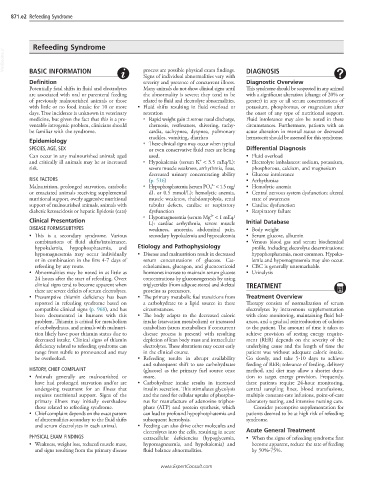Page 1734 - Cote clinical veterinary advisor dogs and cats 4th
P. 1734
871.e2 Refeeding Syndrome
Refeeding Syndrome
VetBooks.ir
process are possible physical exam findings.
BASIC INFORMATION
Signs of individual abnormalities vary with DIAGNOSIS
Definition severity and presence of concurrent illness. Diagnostic Overview
Potentially fatal shifts in fluid and electrolytes Many animals do not show clinical signs until This syndrome should be suspected in any animal
are associated with oral or parenteral feeding the abnormality is severe; they tend to be with a significant alteration (change of 20% or
of previously malnourished animals or those related to fluid and electrolyte abnormalities. greater) in any or all serum concentrations of
with little or no food intake for 10 or more • Fluid shifts resulting in fluid overload or potassium, phosphorous, or magnesium after
days. True incidence is unknown in veterinary retention the onset of any type of nutritional support.
medicine, but given the fact that this is a pre- ○ Rapid weight gain ± serous nasal discharge, Fluid intolerance may also be noted in these
ventable iatrogenic problem, clinicians should chemosis, restlessness, shivering, tachy- circumstances. Furthermore, patients with an
be familiar with the syndrome. cardia, tachypnea, dyspnea, pulmonary acute alteration in mental status or decreased
crackles, vomiting, diarrhea hematocrit should be assessed for this syndrome.
Epidemiology ○ These clinical signs may occur when typical
SPECIES, AGE, SEX or even conservative fluid rates are being Differential Diagnosis
Can occur in any malnourished animal; aged used. • Fluid overload
+
and critically ill animals may be at increased ○ Hypokalemia (serum K < 3.5 mEq/L): • Electrolyte imbalances: sodium, potassium,
risk. severe muscle weakness, arrhythmia, ileus, phosphorous, calcium, and magnesium
decreased urinary concentrating ability • Glucose intolerance
RISK FACTORS (p. 516) • Arrhythmias
2−
Malnutrition, prolonged starvation, catabolic ○ Hypophosphatemia (serum PO 4 < 1.5 mg/ • Hemolytic anemia
or emaciated animals receiving supplemental dL or 0.5 mmol/L): hemolytic anemia, • Central nervous system dysfunction: altered
nutritional support, overly aggressive nutritional muscle weakness, rhabdomyolysis, renal state of awareness
support of malnourished animals, animals with tubular defects, cardiac or respiratory • Cardiac dysfunction
diabetic ketoacidosis or hepatic lipidosis (cats) dysfunction • Respiratory failure
2+
○ Hypomagnesemia (serum Mg < 1 mEq/
Clinical Presentation L): cardiac arrhythmia, severe muscle Initial Database
DISEASE FORMS/SUBTYPES weakness, anorexia, abdominal pain, • Body weight
• This is a secondary syndrome. Various secondary hypokalemia and hypocalcemia • Serum glucose, albumin
combinations of fluid shifts/intolerance, • Venous blood gas and serum biochemical
hypokalemia, hypophosphatemia, and Etiology and Pathophysiology profile, including electrolyte determinations:
hypomagnesemia may occur individually • Disease and malnutrition result in decreased hypophosphatemia, most common. Hypoka-
or in combination in the first 4-7 days of serum concentrations of glucose. Cat- lemia and hypomagnesemia may also occur.
refeeding by any route. echolamines, glucagon, and glucocorticoid • CBC is generally unremarkable.
• Abnormalities may be noted in as little as hormones increase to maintain serum glucose • Urinalysis
24 hours after the start of refeeding. Overt concentrations by gluconeogenesis by using
clinical signs tend to become apparent when triglycerides (from adipose stores) and skeletal TREATMENT
there are severe deficits of serum electrolytes. proteins as precursors.
• Presumptive thiamin deficiency has been • The primary metabolic fuel transitions from Treatment Overview
reported in refeeding syndrome based on a carbohydrate to a lipid source in these Therapy consists of normalization of serum
compatible clinical signs (p. 968), and has circumstances. electrolytes by intravenous supplementation
been documented in humans with this • The body adapts to the decreased caloric with close monitoring, maintaining fluid bal-
problem. Thiamin is critical for metabolism intake (starvation metabolism) or increased ances, and a gradual reintroduction of calories
of carbohydrates, and animals with malnutri- catabolism (stress metabolism if concurrent to the patient. The amount of time it takes to
tion likely have poor thiamin status due to disease process is present) with resulting achieve provision of resting energy require-
decreased intake. Clinical signs of thiamin depletion of lean body mass and intracellular ment (RER) depends on the severity of the
deficiency related to refeeding syndrome can electrolytes. These alterations may occur early underlying cause and the length of time the
range from subtle to pronounced and may in the clinical course. patient was without adequate caloric intake.
be overlooked. • Refeeding results in abrupt availability Go slowly, and take 5-10 days to achieve
and subsequent shift to use carbohydrates feeding of RER; tolerance of feeding, delivery
HISTORY, CHIEF COMPLAINT (glucose) as the primary fuel source once method, and diet may allow a shorter dura-
• Animals generally are malnourished or more. tion to target energy provision. Frequently,
have had prolonged starvation and/or are • Carbohydrate intake results in increased these patients require 24-hour monitoring,
undergoing treatment for an illness that insulin secretion. This stimulates glycolysis central sampling lines, blood transfusions,
requires nutritional support. Signs of the and the need for cellular uptake of phospho- multiple constant-rate infusions, point-of-care
primary illness may initially overshadow rus for manufacture of adenosine triphos- laboratory testing, and intensive nursing care.
those related to refeeding syndrome. phate (ATP) and protein synthesis, which Consider preemptive supplementation for
• Chief complaint depends on the exact pattern can lead to profound hypophosphatemia and patients deemed to be at high risk of refeeding
of abnormalities secondary to the fluid shifts subsequent hemolysis. syndrome.
and serum electrolytes in each animal. • Feeding can also drive other molecules and
electrolytes into the cells, resulting in acute Acute General Treatment
PHYSICAL EXAM FINDINGS extracellular deficiencies (hypoglycemia, • When the signs of refeeding syndrome first
• Weakness, weight loss, reduced muscle mass, hypomagnesemia, and hypokalemia) and become apparent, reduce the rate of feeding
and signs resulting from the primary disease fluid balance abnormalities. by 50%-75%.
www.ExpertConsult.com

